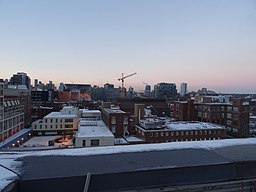Are Immigrants Driving Up Housing Prices?

Approximately 46,000 rich foreigners have used the Quebec Immigrant Investor Program (QIIP) to immigrate to BC and Ontario, and in particular Vancouver and Toronto and their surrounding areas, helping to cause real estate prices to sore in the markets.
According to a Global News report, approximately 46,000 rich foreigners have used the Quebec Immigrant Investor Program (QIIP) to immigrate to BC and Ontario, and in particular Vancouver and Toronto and their surrounding areas, helping to cause real estate prices to sore in the markets.
The program is supposed to encourage investment in Quebec but, aside from the initial $800,000 loan to the province, it seems as though most immigrants are spending their money elsewhere.
The immigrants are mostly believed to come from east Asia, particularly China.
Vancouver
by Kenny Louie / Wikimedia Commons / CC BY 2.0
Nearly 50% of all immigrants who have come to Canada through the QIIP over the last 30 years now live in BC, with the vast majority of those living in the Greater Vancouver Area. Because they are permanent residents of Canada, foreign buyer or ownership taxes do not apply to their purchases.
As of 2016, the 27,000 or so immigrants who came to BC through the QIIP lived in 15,285 households. If you assume each household brought a mere CAD$1 million with them, the impact on the Greater Vancouver real estate market can be readily seen. (These families need to have a net worth of at least CAD$1.6 million to immigrate to Quebec.) At $1 million per household, that’s an influx of around CAD$500 million per year into the BC economy.
A university of British Columbia economist, Giovani Gallipoli estimates that the real estate investment from these QIIP immigrants makes up about 67% of the annual Greater Vancouver real estate market, an estimate he views as conservative. See the Global News Report for the formula.
The estimates are rough because the full picture is not available for various reasons.
Update: In February, the foreign buyer tax was raised from 15% to 20%, though this obviously does not affect anyone who arrived in BC through the QIIP. The government intends to introduce a speculation tax on houses held without resident owners or tenants sometime later this year.
Toronto
by booledozer / Wikimedia Commons / CC BY-SA 2.0
The impact is smaller and less well understood in the Greater Toronto Area (GTA). More than 1/3 of all QIIP immigrants in the last 30 years have settled in Ontario, and the vast majority of those have settled in the GTA.
But because the number of immigrants is smaller and the population of the GTA is significantly larger than the Greater Vancouver Area, it’s harder to estimate the economic impact. Depending upon how you draw the boundaries, there are at least 6.5 million people in the GTA, while there are only about 2.5 million people in the Greater Vancouver Area.
So the impact in the GTA is likely far smaller than the gigantic impact the QIIP is probably having on the real estate market in the Lower Mainland.
Does Anyone Stay in Quebec?
As you can see from the above graph from Global News, few QIIP immigrants stay in Quebec. The article quotes to recent QIIP immigrants, who are still in Quebec, as saying that Toronto and Vancouver offer significant advantages over Montreal: there are more people who speak your language, there’s likely to be family, the weather’s better, and so forth. All of these reasons for relocation seem reasonable, but that doesn’t help the Canadians who can no longer afford houses in the GTA and GVA.
![Condo boom in Vancouver By Kenny Louie from Vancouver, Canada (Work in progress) [CC BY 2.0 (http://creativecommons.org/licenses/by/2.0)], via Wikimedia Commons](https://upload.wikimedia.org/wikipedia/commons/thumb/e/e2/Work_in_progress_%282389678431%29.jpg/640px-Work_in_progress_%282389678431%29.jpg)
![Toronto condo construction By booledozer [CC BY-SA 2.0 (https://creativecommons.org/licenses/by-sa/2.0) or Public domain], via Wikimedia Commons](https://upload.wikimedia.org/wikipedia/commons/thumb/7/72/Looking_east_at_the_reconstruction_of_the_old_National_Hotel%2C_2014_12_06_%281%29_%2815960778741%29.jpg/360px-Looking_east_at_the_reconstruction_of_the_old_National_Hotel%2C_2014_12_06_%281%29_%2815960778741%29.jpg)